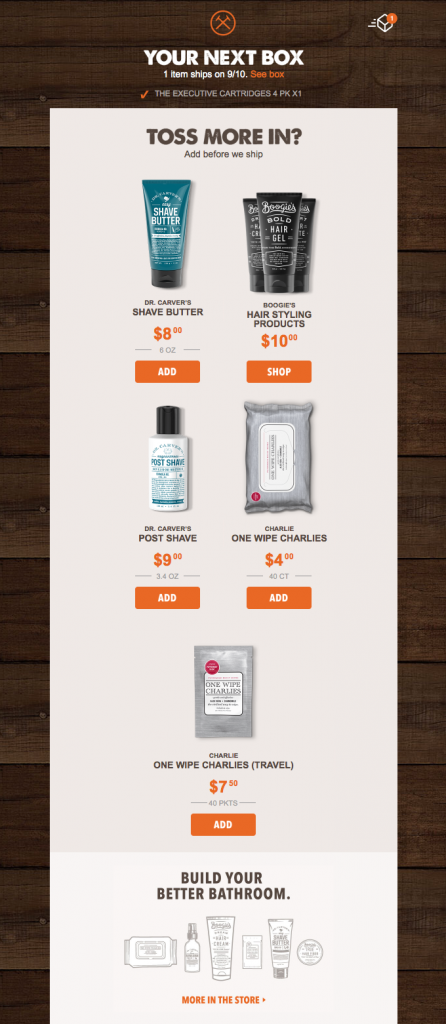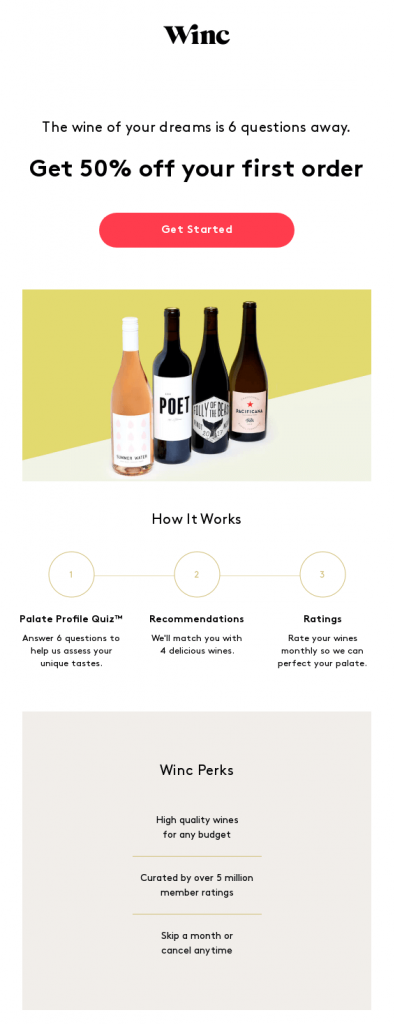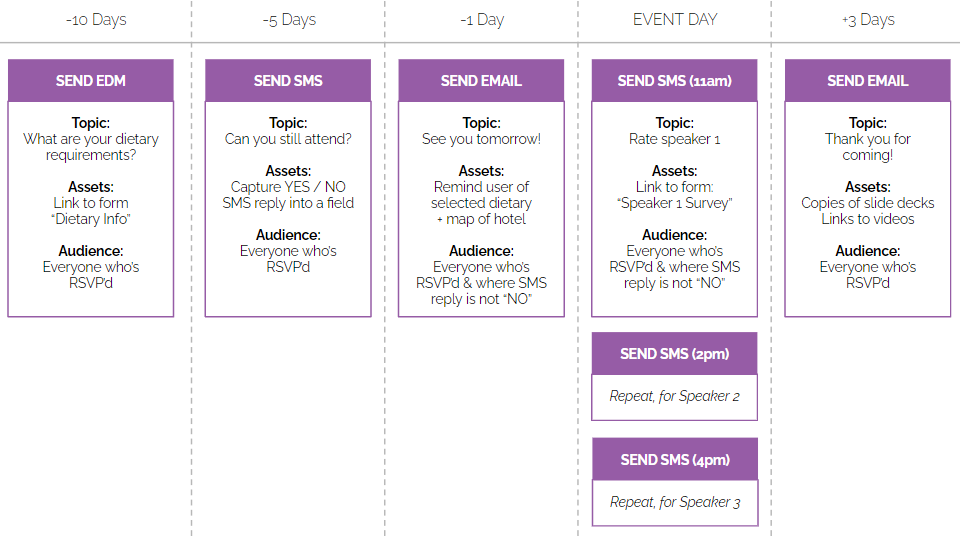Email marketing automation is crucial to any business looking to scale their marketing strategies and grow. Setting up automation workflows for your most important communications like confirmations, onboarding or welcome emails will not only save you valuable time but make sure you’re interacting with your customers at the time it matters most.
In fact, these types of triggered emails have a 70.5% higher open rate and 152% higher click-through rate than generic email newsletters. So your workflows are likely to have a much higher engagement rate, better results, and greater ROI. Here’s how you can make the most of these 5 email automations to help your clients reap greater results from their email marketing campaigns.
What is email marketing automation?
Email automation allows you to schedule, send and manage emails automatically, so you don’t have to be on the clock 24/7! Unlike your promotional emails, automated emails are highly personalised to the customer journey. They can be based on a significant date or a customer interaction with your brand.
Here’s a few examples of email automations that you should consider setting up:
| Date-based triggers | Behaviour-based triggers |
| – Subscriber or company birthdays – First-purchase anniversary – Post-event thank you email – A reminder email for a trial expiry – Celebrating an anniversary of a signup date or membership | – Abandoned cart email – Notification email for password resets, updates to profile or preferences – Confirmation emails for purchases or downloads Sending – Feedback emails after a customer interaction – Unsubscribe email – An onboarding series for new trial signups – Welcome email for new subscribers |
Why should you use email automation?
65% of marketers use email automation to support their marketing efforts, which isn’t surprising considering how many benefits there are.
Provides a highly personalised experience at every touchpoint
Email marketing automation can be a great way to reach and engage your customers at every stage of their journey. By integrating your website analytics into your email marketing software you can target your visitors with automated emails that are based on their interactions with the brand, preferences and recent purchases.
Keeps existing customers interested
Email automation is the perfect tool for customer retention strategies. Just because you converted your leads into customers doesn’t mean your job finishes there. If you want to increase your customer lifetime value you can set a series of automation journeys that keep your existing customers or subscribers active and engaged with your brand.
You can automate feedback requests, trigger a discount or promo code for certain high-paying customers or set up a re-engagement campaign if you haven’t from a customer in a while. All of these email automation strategies will help strengthen your relationships with customers and keep your messaging consistent so your brand stays top-of-mind.
Can save valuable time for your marketing team
Automation can save your team time by reducing the number of manual tasks, so you can focus on more important things, like developing new content or marketing campaigns. Another great benefit of using email automation tools is that they can speed up the process of sending specific types of emails. For example, if you sell products online, you might use an email automation tool to send sales letters automatically based on customer data. This helps to target people most likely to buy your product quickly. Email automation is a great way to improve your marketing efforts.
Additionally, you can use email and marketing automation to track customer engagement and response rates. You can adjust your messaging and marketing strategies by tracking these metrics. Overall, email automation is an extremely effective way to save your marketing team’s time while still delivering high-quality customer service. Using these tools correctly, you can create a powerful marketing strategy to impress your clients and gain their trust.
Email Automation Examples
There are endless possibilities for using email automation in your business. By taking advantage of the technology available, you can create systems that will help you streamline your workflow and help you better serve your customers.
1. Ecommerce email automation
Many of your eCommerce clients will rely on email automation to send out order confirmations, abandoned cart series, suggested product emails, and more. These are essential for customer experience, customer retention, and generating more sales.
There is no denying the effectiveness of in-person interactions, but maintaining frequent contact with your consumers even when they’re not shopping has intangible benefits for your business expansion. This helps keep customers motivated and on track with their shopping, which can result in higher sales. Other common email automation uses cases include:
- Sending confirmation emails after a customer makes a purchase.
- Sending account updates and password reset instructions.
- Sending thank-you messages after a customer completes a transaction.
This is a key area for big wins with your client; any improvements you can make to these workflows will lead to better sales results. By offering management for their eCommerce automation you will take a big weight off their shoulders and let them focus on running their business.
Want to take your clients’ eCommerce automations to the next level? Take a look at the e-commerce email automation below and how they’ve used it as an opportunity to upsell.

2. Welcome email series
A welcome series aims to build trust, loyalty, and credibility with customers. Setting up a welcome email automation is the perfect way to share the brand story that your business has worked so hard to build.
Rather than sending a single welcome email, a series of carefully crafted emails can be much more effective. In fact, sending an onboarding series can generate about 51% more revenue than one welcome email. At this point in the journey, most customers are at their peak interest and want to learn more about the brand. Taking advantage of this will drive a higher engagement rate for your clients’ email campaigns.
The content you include in your welcome or onboarding series will depend on the client. You can send things like extra resources, how-to guides and support articles, feedback forms, and relationship-building check-ins.
Here are some examples of interesting automated welcome emails to help get you started:
- Sharing extra resources, how-to guides and support articles to help newcomers learn how to use certain features, and navigate your site or app.
- A reminder about upcoming events or special offers that will be of interest to them.
- Thanking your subscribers for signing up and providing feedback forms, and relationship-building check-ins.
You can also send different welcome series to different audience segments. This will help to better personalise the content, educate customers on their specific product or service, and speak directly to their needs.
Need some inspiration? This welcome email encourages new subscribers to take a survey with a discount incentive. Getting valuable information from the get-go means you’ll be able to make the most of advanced segmentation to send emails that are tailored specifically to a subscriber’s preferences, favourite item or service, budget etc.

3. Automated emails for gated conent
Gated content is ripe with email automation opportunities. By using Vision6 forms to gate your content you can easily collect all the data you need to generate leads, grow your clients’ email lists, and boost website traffic. Email marketing automation solutions like Vision6 allow you to set a range of workflows: automatically sending welcome emails, following up with related content, offering products or services, or re-engaging them with discounts or special offers. There are a number of workflows you can set up, and you can segment the leads depending on the content they download and how they engage with it.
Emails can also feature gated content offers, driving existing and inactive subscribers to the necessary page or attracting attention to a particular product category. These emails can act as the starting point in a content workflow, and if subscribers are happy with what they get from gated content, they are much more likely to engage with further email campaigns.
Need help proving the ROI of your email marketing efforts to clients? Hear from three amazing speakers in our video: Prove the ROI of Your Marketing Effort.
4. Automated SMS marketing
Automation is not just useful in the realm of emails. Your email and SMS marketing tools can join forces to reach more people and supercharge your campaigns. The average person checks their phone about 110 times a day, and 90% of people read an SMS within 3 minutes. Including SMS in your client’s marketing automations is a simple but powerful way to get better results for your clients and impress them at the same time.
Some clients may still be unsure about how SMS marketing works, particularly if they’re not tech-savvy, but it’s simple to implement for them and can be fully automated. Not only is it a powerful and simple marketing tactic, but it also gives you impressive and detailed reports to deliver to your clients.
You can use personalised SMS for any number of automations:
- Send out reminders and ticket information as part of your event automation
- Provide discounts and special offers for your welcome series
- Set up abandoned cart notifications as part of your eCommerce workflows
- Reminders about limited sale offers or discount expiries
- Or for any other type of automated campaign
5. Event email automation
For clients that run events, setting up an automation workflow will not only take a weight off their shoulders but also help boost attendance numbers and results.
With email automation, you can set up automatic reminders for yourself and your guests and send out information about the event in advance. Invitation emails, reminders, ticket deals, program releases, and follow-ups; the automation opportunities are endless. Setting up a workflow for your clients will help to maintain momentum for the event and keep attendees excited in the lead-up.
We’ve been perfecting our own event marketing with our EMSA events every year, so we know the power of automation. Take a look at our Pre- and Post-Event Comms Workflow how-to guide to see how to set up your event automations.

If you need some more tips for running awesome events for your clients? Check out our event automation blueprint.
Conclusion
Email automation is more in demand than ever, with 49% of companies now using it as part of their marketing strategies. As an agency, you should be offering automation in your email marketing package to your clients, not only to help win new clients but also to retain your existing client base.
There are, however, some best practices that you should follow to ensure that your email marketing automation is effective. Some best practices include segmenting your audience, personalising your emails, timing your emails properly, and providing value in your emails.
Overall, email marketing automation can be a helpful tool for businesses when used correctly. By planning and considering their goals and target audience, businesses can maximise the effectiveness of their email campaigns and see significant results. Still not sure why you should be offering email marketing? Here’s a quick rundown of the benefits for you and your clients, as well as ways to present the product to your clients.



